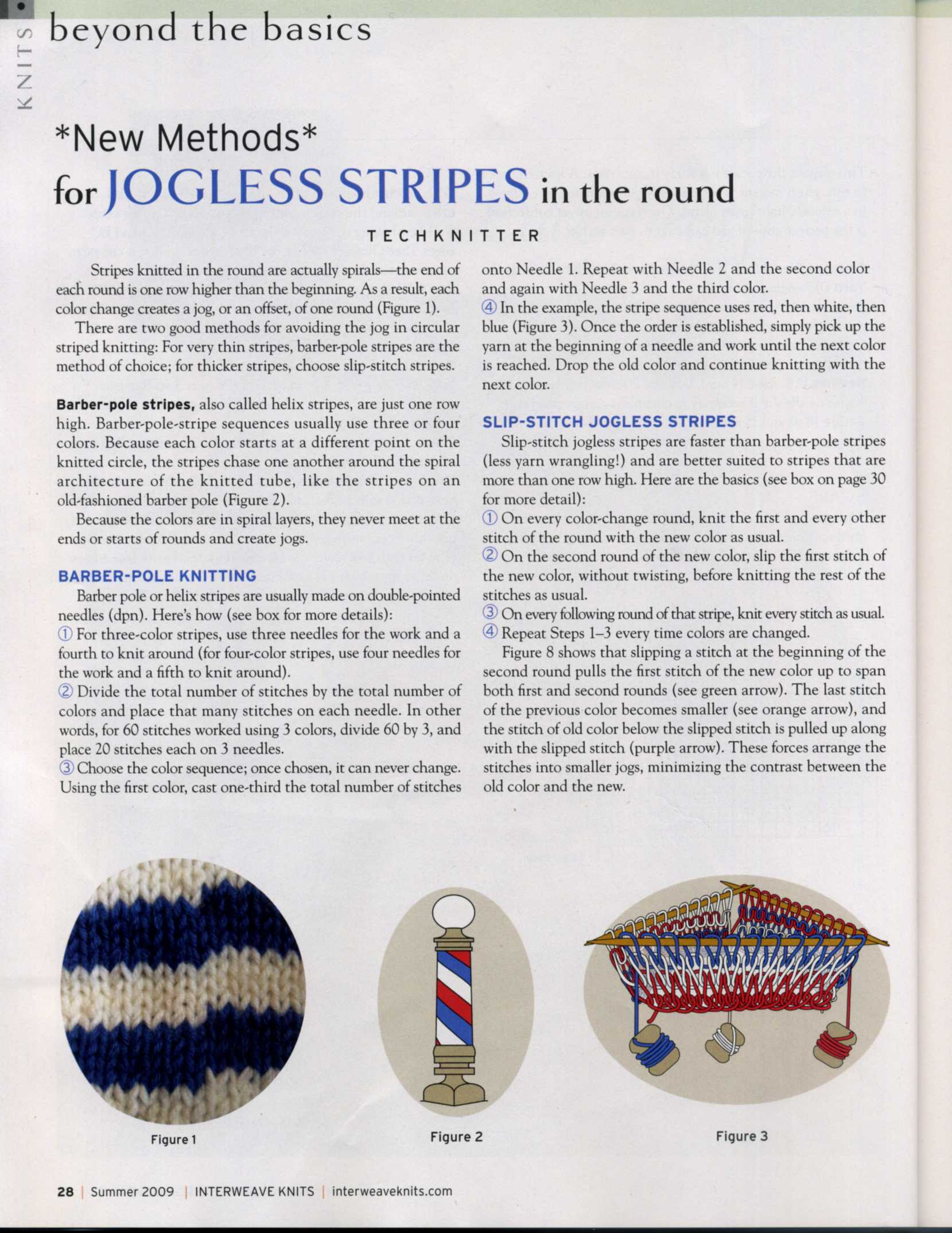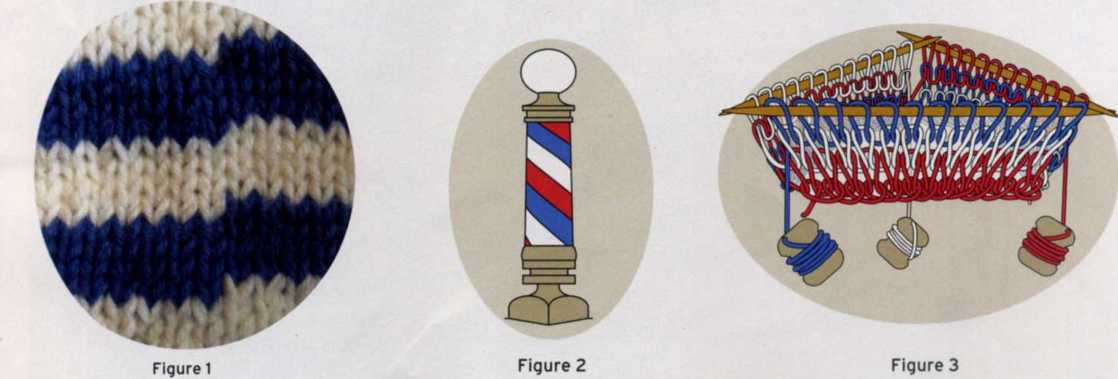img009 (43)

K N ITS

*New Methods*
for jOCLESS STRIPES in the round
TECHKNITTER
Stripes knitted in the round are actually spirals—the end of each round is one row higher than the beginning. As a result, each color change creates a jog, or an offset, of one round (Figurę 1).
There are two good methods for avoiding the jog in circular striped knitting: For very thin stripes, harber-pole stripes are the method of choice; for thicker stripes, choose slip-stitch stripes.
Barber-pole stripes, also called helix stripes, are just one row high. Barber-pole-stripe sequences usually use three or four colors. Because each color starts at a different point on the knitted circle, the stripes chase one another around the spiral architecture of the knitted tubę, like the stripes on an old-fashioned barber pole (Figurę 2).
Because the colors are in spiral layers, they never meet at the ends or starts of rounds and create jogs.
BARBER-POLE KNITTING
Barber pole or helix stripes are usually madę on double-pointed needles (dpn). Here’s how (see box for morę details):
(D For three-color stripes, use three needles for the work and a fourth to knit around (for four-color stripes, use four needles for the work and a fifth to knit around).
(D Divide the total number of stitches by the total number of colors and place that many stitches on each needle. In other words, for 60 stitches worked using 3 colors, divide 60 by 3, and place 20 stitches each on 3 needles.
(D Choose the color seąuence; once chosen, it can never change. Using the first color, cast one-third the total number of stitches
onto Needle 1. Repeat with Needle 2 and the second color and again with Needle 3 and the third color.
(4) In the example, the stripe seąuence uses red, then white, then blue (Figurę 3). Once the order is established, simply pick up the yarn at the beginning of a needle and work until the next color is reached. Drop the old color and continue knitting with the next color.
SLIP-STITCH JOGLESS STRIPES
Slip-stitch jogless stripes are faster than barber-pole stripes (less yarn wrangling!) and are better suited to stripes that are morę than one row high. Here are the basics (see box on page 30 for morę detail):
© On every color-change round, knit the first and every other stitch of the round with the new color as usual.
(D On the second round of the new color, slip the first stitch of the new color, without twisting, before knitting the rest of the stitches as usual.
(D On every following round of that stripe, knit every stitch as usual. @ Repeat Steps 1-3 every time colors are changed.
Figurę 8 shows that slipping a stitch at the beginning of the second round pulls the first stitch of the new color up to span both first and second rounds (see green arrow). The last stitch of the previous color becomes smaller (see orange arrow), and the stitch of old color below the slipped stitch is pulled up along with the slipped stitch (purple arrow). These forces arrange the stitches into smaller jogs, minimizing the contrast between the old color and the new.

28 Summer 2009 INTERWEAVE KNITS interweaveknits.com
Wyszukiwarka
Podobne podstrony:
CPTWD (Cone Penetration Test While Drilling) a new method for deep geotechnical surveys Authors :
4Abstract The monograph is dedicated to developing new methods for ultrasonic nondestructive testing
00215 ?0e621dbf006c49e21a7837633685a1 217 Applications of the EWMA This paper (1) describes a metho
img011 (41) LT>beyond the basics z Notę: Jogless stripes in the round are useful for many knittin
img011 (41) LT>beyond the basics z Notę: Jogless stripes in the round are useful for many knittin
img011 (41) LT>beyond the basics z Notę: Jogless stripes in the round are useful for many knittin
img011 (41) LT>beyond the basics z Notę: Jogless stripes in the round are useful for many knittin
skanuj0254 mXP LAM ATI OM OF SYMBOLS = Picots for joining or ornamcntation. The figures are the
New test methods for MIMO OTA measurements Currently, OTA performance tests for single input si
236 Jarosław Grainacki. Artur Gramacki 43 [C] Practical Methods for Optimal Contro
screenshot1 £ The Tyler Method For Successful Triangle Trading - Windows Internet Explorer C:New Fol
43 1. Alkhimov, A. P. , A. T. Gorbachev, and A. N. Papyrin (0). Method for high-speed photorccording
flash Netscape - [Flashing text applet]Hello. world! Enter new text for the flashing display: I Clic
image033 * Then I saw a new heaven and a new earth: for ttie first heaven and the first earth had pa
więcej podobnych podstron